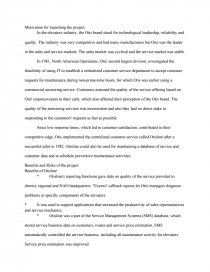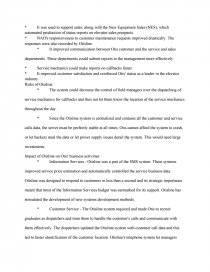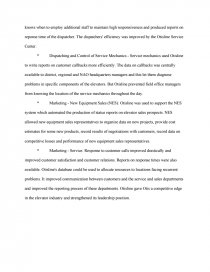Motivation for Launching the Project
Essay by afzal.hussain • January 1, 2013 • Essay • 779 Words (4 Pages) • 1,264 Views
Motivation for launching the project:
In the elevators industry, the Otis brand stood for technological leadership, reliability and quality. The industry was very competitive and had many manufacturers but Otis was the leader in the sales and service markets. The sales market was cyclical and the service market was stable.
In 1981, North American Operations, Otis' second largest division, investigated the feasibility of using IT to establish a centralized customer service department to accept customer requests for maintenance during non-prime-time hours, for which Otis was earlier using a commercial answering service. Customers assessed the quality of the service offering based on Otis' responsiveness to their calls, which also affected their perception of the Otis brand. The quality of the answering services was inconsistent and also they had no direct stake in responding to the customers' requests as fast as possible.
Since low response times, which led to customer satisfaction, contributed to their competitive edge, Otis implemented the centralized customer service called Otisline after a successful pilot in 1982. Otisline could also be used for maintaining a database of service and customer data and to schedule preventive maintenance activities.
Benefits and Risks of the project:
Benefits of Otisline:
* Otisline's reporting functions gave data on quality of the service provided to district, regional and NAO headquarters. "Excess" callback reports let Otis' managers diagnose problems in specific components of the elevators.
* It was used to support applications that increased the productivity of sales representatives and service mechanics.
* Otisline was a part of the Service Management Systems (SMS) database, which stored service business data on customers, routes and service price estimation. SMS automatically controlled the service business, including all maintenance activity for elevators. Service price estimation was improved.
* It was used to support sales, along with the New Equipment Sales (NES), which automated production of status reports on elevator sales prospects.
* NAO's responsiveness to customer maintenance requests improved drastically. The responses were also recorded by Otisline.
* It improved communication between Otis customer and the service and sales departments. These departments could submit reports to the management more effectively.
* Service mechanics could make reports on callbacks faster.
* It improved customer satisfaction and reinforced Otis' status as a leader in the elevator industry.
Risks of Otisline:
* The system could decrease the control of field managers over the dispatching of service mechanics for callbacks and thus not let them know the location of the service mechanics throughout the day.
* Since the Otisline system is centralized and contains all the customer and service calls data, the server must be perfectly stable at all times. Otis cannot afford the system to crash, or let hackers steal the data or let power supply issues derail the system. This would need large investments.
Impact of Otisline on Otis' business activities:
* Information
...
...


